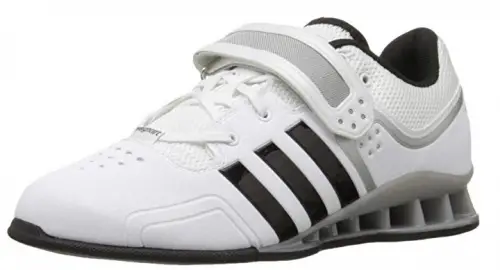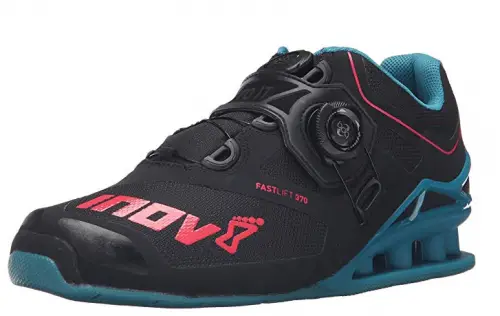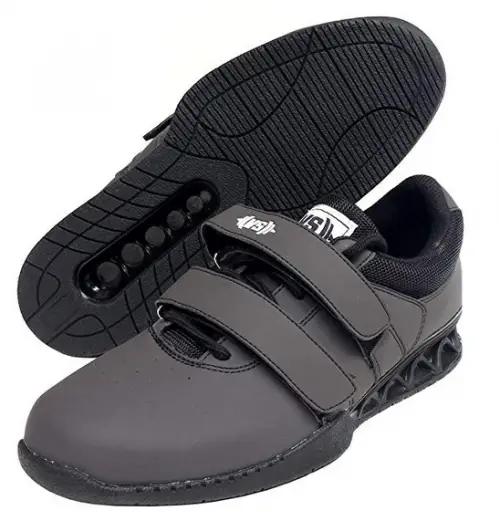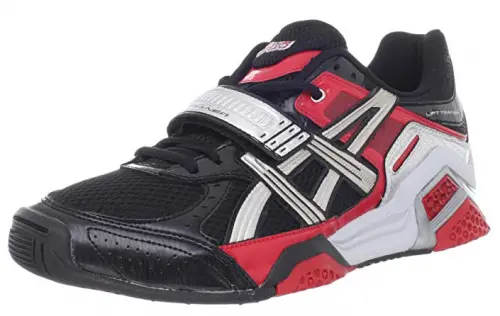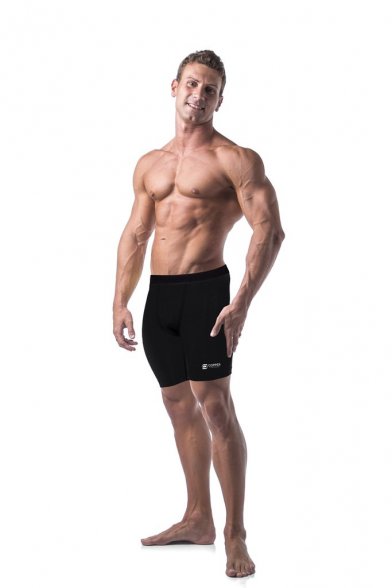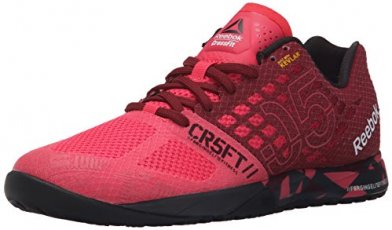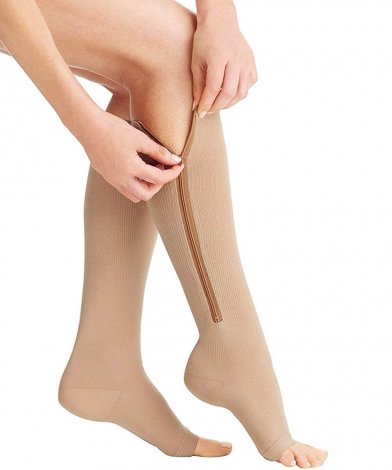The Best Shoes for Weightlifting Reviewed
Today’s best weightlifting shoes are actually a serious part of your gear. Not only can they significantly enhance safety and performance, but they reflect the best in modern style and comfort as well. We’re here to take a look at the cream of the crop for 2019 and provide you with a comprehensive review and roundup of the best shoes for weightlifting. We’ll highlight our favorite and best lifting shoes first and then conduct a more general review of the different brands and categories of powerlifting shoes and reveal our picks for the best of each along the way.
This is the best product on our list that is currently in stock:

Superior ventilation
Improved stability
Improved design
PU-coated Leather Upper
10 Best Weightlifting Shoes
1. Reebok Legacy Lifter
TPU Heel Piece
Perforated Synthetic Leather Upper
Anatomical Shape
Grip Rubber Outsole
Exoframe Technology
Takes Some Breaking In
Reebok’s brand new Legacy Lifter is their showcase only shoe. These powerlifting shoes feature a TPU heel, ensuring that you have an in-compressible heel that is both lightweight and durable. The conventional double metatarsal straps in these shoes for weightlifting are joined by an extra lacing strap to deliver superior foot security.
Read moreA gap in the top medial velcro strap allows you to quickly tuck your laces into these lifting shoes. The Legacy is a super comfortable lifting shoe that features full-grain leather. An outside TPU counter locks in your heel to prevent slippage. The shape of these lifting shoes is anatomical, complete with double upper straps for a customized fit. The grip rubber on the outsoles gives you traction and lasts ages. The heel has specialized exoframe technology that gives you even more support, making these shoes the best squat shoes out there for lifting!
2. Nike Metcon 2
100% Mesh
Super-strong Flywire Cables
Stable Platform
Solid Rubber Sole
Lightweight Cushioning
Sizing Issues
The Nike Metcon 2 are amazingly versatile powerlifting shoes that introduce an updated drop-in midsole to provide maximum forefoot stability and flexibility. The low profile firm rubber heel on these shoes for weightlifting delivers a solid base for heavy lifting.
Read moreFlywire technology makes use of lightweight Vectran filaments to give ultimate structure and support. Such features as molded flex grooves on the forefoot embroidered TPU reinforcement, and the lightweight construction makes Nike Metcon 2 great weightlifting shoes to tackle the varied challenges of CrossFit training. The upper is made out of mesh, offering breathability and improved air circulation. The solid rubber sole creates enough traction to keep you anchored to the ground.
Looking or more information about this model? Read our full review of Nike Metcon 2 shoes.
3. Adidas Powerlift 3
High-Density Midsole
Grippy Outsole
Lightweight Synthetic Upper
Lock-in Fit
Air Mesh Material
Heel Loses Shape
The lightweight synthetic upper on these shoes for weightlifting comes with an instep strap closure system for great support and lock-in fit. The lining and collar of the tongue comprise air mesh material to vastly improve breathability and reduce moisture.
Read moreThe Adidas Powerlift 3 are multi-use weightlifting shoes that allow you to squat, deadlift and power clean without having to change your footwear. It features a high-density midsole along with a grip-friendly outsole to provide you with maximum foundational stability.
4. Adidas Men's Adipower
Superior ventilation
Improved stability
Improved design
PU-coated Leather Upper
Narrow Fit
There’s little if anything to dislike about the Adidas Adipower weightlifting shoes. Adipower helps Adidas stay firmly atop the shoes for the weightlifting pyramid by being a marked upgrade from its predecessor - the already excellent Adistar. These powerlifting shoes are made out of leather, giving them supreme durability and flexibility, once you break them down.
Read moreThe upper on these shoes for weightlifting is coated in PU, giving it shine and resistance to all kinds of weather conditions. The TPU midsole is firm and strong, supporting you a lot. The adjustable hook-and-loop holds down your rear foot and creates an ideal fit. The heel overlays are lightweight yet give plenty of stability. The anti-slip rubber sole in these lifting shoes keeps you safe when you lift heavy weights, while the vent flow openings keep you cool and fresh.
5. Nike Romaleos 3
Flywire Technology
Flexible Forefoot
Honeycomb-patterned TPU Plate
Synthetic Leather
20 mm Offset
Too Narrow
With the Romaleos 3 shoes for weightlifting, Nike states their intent to knock Adidas from the top of the ”best weightlifting shoes“ heap if not soon, then eventually. That ability to customize the color of the R2 makes it a prime example of how performance does not have to be sacrificed for the best powerlifting shoes to achieve great styling.
Read moreThe Flywire technology gives integrity to the lifting shoes, making them stronger and less likely to fall apart. The forefoot is quite flexible, allowing your feet to move naturally within the shoes, not constricting your movement when you don't need them to. The TPU plate in these best shoes for squats and weightlifting is honeycomb patterned for improved stability. The upper combines synthetic leather and mesh for a lighter feel and better durability. The offset has 20 mm for even more range of motion.
6. Reebok CrossFit Lifter Plus 2.0
Leather Toes
Great Design
Dual Hook-and-loop Closure
Flex Grooved Outsole
Anti-friction lining
Rubber Separates Fast
The CrossFit Lifter Plus 2.0 is one of the best shoes to squat in while weightlifting currently available. With dual tarsal strap and smart, the well-balanced design of these powerlifting shoes is an eye-catcher that also delivers on the performance side in impressive fashion.
Read moreThe material that makes up these powerlifting shoes changes throughout its construction. The toes are covered in leather for improved durability, while the rest of the best shoes for weightlifting is made out of mesh, giving it flexibility and breathability. The dual hook-and-loop closures keep you locked in tightly while you tackle heavyweights. The heat-activated u-form technology creates that ideal fit we all crave when buying shoes. The flex grooved outsole provides you with excellent traction. An anti-friction lining keeps you safe from blisters and chafing.
7. Pendlay Do-Win
Synthetic Leather And Mesh Blend
Wide Profile
Improved Breathability
3-4 Inch Heel Height
Two Metatarsal Straps
Pricey
Pendlay hasn’t been making weightlifting shoes very long but they hit their stride right out of the gate. The Do-Win 14P Black shoe boasts a wide profile for extra comfort and a hard plastic heel that reduces the shoe’s weight while giving you all the support you need when going at it at the gym.
Read moreThe upper blends synthetic leather and nylon mesh for an ideal construction. The leather keeps the shoe strong, while the mesh promotes airflow to keep you cool and well ventilated. The sole is improved and made to be stronger, withstanding a lot of weight. The heel is 3-4 inches high, which is just enough to keep your foot in a natural position when you squat or lift. These best shoes for weightlifting even have a 90-day warranty, so if anything goes wrong to know that your shoes are safe! Perhaps the area where Pendlay most obviously separates themselves from their competition in the mid-priced WL footwear market is style. These are great looking lifting shoes and for that, you’ll have to pony up a bit more.
8. Inov8 Fastlift 370 Boa
Cutting Edge Profile
Lightweight Construction
Innovative Lacing Design
Excellent Grip And Stability
Too Much Padding
The New Zealand company Inov8 first caught the eye of lifters with their Fastlift 335 model (so named for their weight, a svelte 335g) a few years back. The recent release of their follow-up to the 335 - the 370 Boa - proves that Inov8 is no flash in the pan. The 370 Boa is Inov8’s grab for the “best lifting shoe” brass ring and features a revolutionary closure system.
Read moreThat system - the “Boa” of the shoe’s name - allows the user to adjust the tension on the strap of these powerlifting shoes by turning a built-in dial that eliminates the need for laces! These best shoes for weightlifting even look like a piece of contemporary art, so be prepared to look good while lifting heavy. The tongue and collar are lightly padded to keep you safe from friction and annoying pinching and rubbing. The foam footbeds are 3 mm thick, and they are removable if you ever get the need to replace them. The FASTLIFT sole has a 0mm lug depth, giving you grip on every outdoor and indoor surface!
9. VS Athletic Weightlifting Shoe II
Dual hook and loop straps
Flat leather-reinforced sole
Strengthened heel counter
Real leather upper
Straps Too Long
Well built, affordable and performance-oriented, the VS Athletic Weightlifting Shoe II is much admired by both novice and experienced lifters. Costing under $100 this weightlifting shoe offers amazing value and one that you would be disappointed to not at least consider the next time you are out shopping for a new pair of weight lifting shoes. To learn more about the VS Athletic lifting shoes read our in-depth VS Athletic weightlifting shoe review. Don't buy until you've read this article!
Read moreThe upper is made out of genuine leather, which is rare to see today since it's replaced by synthetic leather most of the time. There are some mesh areas present that increase the breathability of the shoe. This shoe offers a dual hook and loop feature that helps improve your stability and give you much-needed support. The sole is reinforced flat leather which helps with overall durability and offers you the support and stability you need when you are lifting weights. The heel counter is strengthened, so do not be afraid to go really heavy when wearing these powerlifting shoes!
10. ASICS Men's Lift Trainer Cross-Trainer
Synthetic Leather And Mesh
Padded Collar And Tongue
Mesh Lining
Dual-density DuoMax® Support System
Forefoot GEL® Cushioning System
Runs Large
The Japanese company Asics has been around since 1949. In spite of their significant share of the ever-changing athletic footwear market, however, Asics has continued to manufacture the exact same weightlifting shoes they made 50 years ago. The Asics Men's Lift Trainer Cross-Trainer you buy today is made from the same template and materials as 30 years ago. That’s good because it’s among the best shoes for powerlifting, but bad because the design fairy has been frozen out.
Read moreThese lifting shoes are 100% synthetic, combining synthetic leather and mesh elements that brings out the best in them. The padded collar and tongue keep your feet locked in and prevent chafing and blisters. The mesh lining is breathable, while the soft sock liner can be removed to be replaced with different liners better fit for your needs. The midfoot support strap locks you down and keeps your arches in check. Dual-density DuoMax® Support System increases support and stability even more, while the rearfoot and Forefoot GEL® Cushioning System absorbs shock and allows you to move pain-free.
Criteria Used for Evaluation

Model
Weightlifting shoes come in a variety of styles to serve a variety of purposes. From straight-up Olympic weight lifting shoes designed and built for one purpose to multidimensional CrossFit models created to save you from having to change shoes when you go from the weightlifting rack to the road. The guide below represents our picks for the best squatting shoes in each category.
First, let's take a look at Crossfit shoes. Crossfit regimes include rope climbing, jumping, running, sled pulling, weightlifting and more and call for a shoe that’s as versatile as you are. Top Crossfit shoes attempt to fill this need by essentially being all things to all sports. They may have a slightly elevated heel to accommodate certain aspects of Oly weightlifting, a slightly cushioned insole for dynamic absorption during running (but not so much as to be useless during squats and deadlifts), sticky outsoles to help you climb that rope easier and often assume a minimalist profile. Take a look at the best shoes for Crossfit and learn more about the benefits of Crossfit shoes in areas of comfort, versatility, and style while treading lightly on your wallet. They’ll feel right at home whether you’re executing squats, climbing the rope or barreling down a muddy cross country trail. Top CrossFit shoes are quasi-minimalist in design and meet traction, shock absorption, weight and breathability requirements of road work while retaining enough stability to handle moderate amounts of weight. The best Crossfit shoes for women also tend toward the minimalist though designers can’t be as willing to throw comfort under the bus as they sometimes are with men’s shoes. That’s because studies show that women who run at a competitive level typically have more rigid feet than the rest of us which brings the need for comfort to the fore.
Now let's go onto shoes made for squatting and deadlifting. If you’re wearing the wrong shoe for squats and deadlifts you’re leaving the weight on the platform. With this type of lifting, you need to have solid, stable, no-nonsense contact with the ground and this is why Converse Chuck Taylor’s have been popular deadlift shoes for so long. They’re great at creating maximum push by getting the most out of your lower legs. For a long time, it was Chuck Taylors or bare feet but that’s not the case anymore. If you like to end your weightlifting session with some time on the track or treadmill you’re going to want a shoe that promotes maximum upward thrust while you’re under the weight but also hugs the ground, which is relatively flexible and is great for putting miles behind you. Best shoes for lifting weights and running need to be durable, stable and flat but light on the cushioning in order to help your feet do what 3 million years of evolution designed them to do. This may be one of the most challenging categories of footwear design and our picks for the best may surprise you. High top, flat-soled, versatile gym shoes are perfect for squats and deadlifts, leg presses and more. In addition, they will serve you well should you decide to take up mixed martial arts, boxing or a slew of other activities that require you to have your feet flat on the ground. High top powerlifting shoes range from the decidedly low-tech to state of the art athletic footwear with clean, professional profiles that evoke both intent and good taste. Check out our choices for the best high top weightlifting shoes. While the raised heel on the Adipower and Romaleos provide stability, superior positioning and the ability to drive downward with maximum force there are times you want a shoe that positions your foot absolutely horizontal to the lifting plane. Flat lifting shoes replicate the natural barefoot stance but with the added grip only a sole can provide. If you have flat feet it can be difficult to find the best weightlifting shoes that will aid you in creating upward push during your deadlifts while also providing arch support. Opinions about exactly which type of shoe may be best for flat-footed lifters run the gamut from work boots to top-of-the-line Nike Romaleos weightlifting shoes.

Effectiveness
The three most obvious benefits of weightlifting shoes are easy to quantify. First, their solid (often wooden) heel ensures the upward force you apply is transferred effectively to the weight where it belongs. Second, this heel forces the shoulders out over the front plane of your body creating a proper dynamic relationship between body and weight. And third a snug, metatarsal strap prevents your foot from sliding laterally and negatively affecting balance and stability. All these features reduce your chance of injury and increase your chance of attaining your personal goals.
This heel also helps you lift better, and you can easily tackle even more weight than what you're used to! This, in turn, gives faster results, and you will see improved muscle growth and you will definitely feel stronger, all thanks to top these shoes! Do not expect to be super-strong just by putting them on though. Proper weightlifting shoes have a special lifted heel, and these heels increase the range of motion of our ankles. A lot of people struggle when starting to squat, and this improved range of motion can help you squat deeper and maintain that perfect form. As you move, the sneakers will also help your hips flex and move the way they are supposed to, and this, combined with the ankle range of motion, means that you will be able to lift heavier weights, which is what the goal is in the first place. The heels also create a stable surface for you to push your feet up against, and this gives you more power to lift even better. This is why you should avoid weightlifting shoes that have plenty of cushioning! This brings us to our final point - do not use the weightlifting shoes for activities that are not weightlifting, as they will not give you any benefits. If, however, you do more than just lifting when you go to the gym, a crossover shoe is what you're going to need because it will cover every need you have!

Use
When you are lifting weights, you expect that all of the force that you generate is going to go towards lifting the weight over the desired distance. Often, though, that is not the case. In many instances, much of your force is dissipated through your foot due to compression. The reason? Too much cushioning in the heel of the shoe. This is like trying to do a squat while standing on a huge marshmallow. Which is why a solid and stable heel is so important. But not everyone needs to go to the expense of buying a pair of weightlifting shoes. For some, it may actually impede their training.
If you are a casual gym-goer who is trying to lose a few pounds then you probably don’t need specialized shoes for lifting weights. Your normal trainers should do the job quite nicely. If you, however, are set bettering yourself, improving your overall sports performance, increasing muscle mass, improving strength or looking to get into CrossFit, then you will want a decent and reliable pair of shoes specifically made for weightlifting. In fact, a quality pair of weightlifting shoes is possibly the greatest investment you can make to improve your performance in the gym.
Olympic weightlifting (or Oly) shoes are usually worn by Olympic weightlifters. Powerlifters also use them, along with Crossfitters when doing Oly type lifts.
Don’t think that you should only buy lifting shoes when you have achieved a certain level of strength. They will benefit a novice who’s only squatting the bar just as much as a veteran lifter who reps out with 600 pounds. Weightlifting shoes won’t turn you into a 660-pound lifter, but they will put your body into the ideal alignment for doing squats.
As a result, you have increased stability and solidity when you are squatting. This will allow you to lift more weight. When you are lifting from a more stable surface, you are naturally able to lift more weight. It all goes back to an old saying that you can't shoot a cannon from a canoe. You need to have a solid base or all of your power will be dissipated. Traditional trainers normally provide the bottoms of your feet with a lot of cushioning around the sides and bottom of the heel. This is the weight training equivalent of shooting a cannon from a canoe; you will lack the solid base that you need to propel the force upward. That’s because the soft cushioning will absorb the force. That is the last thing that you want when you are lifting heavyweight.
The raised heel style weightlifting shoe is ideally suited for back squats. It will also improve your execution, stability, and power when performing front squats, clean and jerk, snatches and overhead squats. They will help your performance whether you are pushing for a new one-rep max or if you’re doing a lightweight of 20 reps.
You should not do deadlifts when wearing raised heel weightlifting shoes. When you are deadlifting you actually want your heels to be as close to the floor as possible. Traditional raised heel weightlifting shoes do just the opposite. That, in effect, means that you are deadlifting in high heels, putting your body at an awkward angle of alignment. Because you are higher from the ground, it also means that you have to lift the bar that little bit higher to get into the top position of the deadlift.
As with most things, however, there is an exception to the don’t deadlift with weightlifting shoes rule. Some guys training with an elevated heel on purpose on the deadlift in order to make themselves stronger in competition when they revert back to standard flat heel shoes. This should only be done under the guidance of a knowledgeable coach as it does carry enhanced risks.
If you are doing multiple exercises in the gym, ranging from squats to plyometrics or upper body exercises, you will probably be better off with a pair of cross-training shoes. You should also avoid wearing your raised heel weightlifting shoes outside of the gym so that they won’t wear out (wear normal trainers to the gym and swap into your weightlifting shoes in the locker room).
If you are a Strongman athlete, Olympic weightlifting shoes may not be the best option for you. Although they will put you in the ideal positioning for squats and provide enhanced stability, they are not conducive to the combined speed and strength moves such as the farmer’s walk or the yoke exercise.
Powerlifters will be less likely to benefit from weightlifting shoes with raised heels than Olympic lifters. That is because powerlifters require less ankle mobility. The added height that you get with the raised heel will also require you to cover more distance in your lift.

Fit
The fit of the shoes will determine how much comfort you feel when wearing them, and comfort matters a lot. Wide feet need wider sneakers, and narrow feet need a slimmer shoe. If your ankles are weaker than normal, go for high top weightlifting shoes that will keep them stable and secure. But how can you tell that you've got the right fit for you?
First, these shoes should feel snug, but don't go thinking that they should squeeze your feet too much! Footwear that fits you to the tee should stick to your heels while still giving your toes some wiggle room. There also shouldn't be plenty of room between the toes and the front of the shoes either. The distance shouldn't be more than 1/8 inches between your longest toe and the end of the toebox. If you feel like your toes are being squished, and you can actually see your little toe bulging from the sides, chances are that you've got the wrong width on. You shouldn't feel exaggerated pain or pinching when you buy your shoes, even if they are brand new. Breaking them in shouldn't be too difficult, and if you always end up feeling pain then it's likely that you've got the wrong size on! Shop when your feet are the largest, which is in the evening because that's when our feet are swollen. This ensures that you will always have the best possible fit!

Heel
Every good weightlifting shoe should have a little heel. This heel gives us much-needed stability and support, and you must make sure that you've got the right heel size for your needs. The heel height of weightlifting shoes can vary a lot, but the standard height is .75-inches. Some athletes still like to put inserts into their footwear to make the heels even higher. These heels help you achieve a greater squatting depth while keeping your torso in the right form.
Before deciding how high your heels need to be, you must take your own body shape into account. How long your legs and torso are is what you need to consider when buying weightlifting shoes. Think hard about whether your torso and legs fall into the short or long category, and once you do figure it out, you can then confidently buy the shoes. If you can't figure it out, ask a physician or a fitness coach to help you. Sometimes, the torso can be long and the legs can be short, or vice versa or they can be of matching length. If you have long legs, go for a heel that is no shorter than the standard height. If you have short legs, the highest heel you can go for is the .75", and you can work your way down from there. If your torso is long, you will likely lean forward and lose your balance when you lift, and that is the last thing you need. Short legs and long bodies need shorter heels, while the opposite situation needs higher heels. Both long legs and torsos need high heels, while short legs and bodies can choose any height they want!
Expert Interviews & Opinions
Comfy shoes are the best shoes, and if your footwear is comfortable you won't waste time thinking about that uncomfortable seam rubbing you raw or the blister forming right now. You must forget about excessive cushioning, or any cushioning at all when buying weightlifting shoes. The padding can make your feet sink into the shoes, and you need solid support. When you've sunk into your shoes, you will need more effort to lift, which can potentially harm you. The seams and stitches of your shoes should not pose a problem either, and if you feel anything slightly poking you when you first put the shoes on, you can count on it to be a big troublemaker later! Before you deem your footwear uncomfortable, make sure that you've broken it in properly first. Once you do that, you can judge the comfort of the shoes!
Weightlifting is hard both for your feet and for the sneakers, so it's vital that they can withstand a lot of pressure. It's always better to go for a pricier shoe that has a better construction than a poorly made cheap one! If you want your sneakers to last long, do not use them for anything else besides weightlifting. If you care about them properly, weightlifting shoes will probably outlast every other kind of shoe you have! If you notice the heels falling apart, if the glue is breaking down, or if the upper starts to crack, it's time to think about finding a replacement. If you still have a valid warranty, consider replacing them for a new pair. The straps should also look just like they did on day one because they provide us with security and support. Check the interior of the shoe as well, and as soon as you see things looking like they shouldn't, it's time to say goodbye!
Other Factors to Consider

Bottom Line
Weightlifting shoes have come a long way since the days of Paul Anderson’s leather Oxfords. Today’s best shoes for weightlifting are the result of years of trial and error, advances in materials and construction methods and comprehensive computer-aided analysis of human physiology. With the re-emergence of free weights as a desirable, even preferable, method of weight training the need for good shoes to lift in has never been greater and neither has the choices. The weightlifting shoe review pages we've put together can help you narrow those choices. Good luck!
Frequently Asked Questions
q: What should I consider when buying powerlifting shoes?
This is something you must be aware of before getting your weightlifting shoes. The most important things to look out for are soles that cannot be compressed (cushion-free), the proper heel height, the support the shoes offer you, how comfy they are, and how they fit you. You can also consider their style and general appearance, but these things do not matter so much when it comes to performance and your well-being!
q: How much should I spend on weightlifting shoes?
How much you spend will be entirely up to you but if you’re a weekend warrior it doesn’t make much sense to drop $250 on a pair of the best Olympic weightlifting shoes when you can buy perfectly functional Wei-Rui weightlifting shoes for $69.
q: How do I know if my lifting shoes fit me well?
The shoes shouldn't allow your feet to wiggle inside too much, but they shouldn't feel overly snug either. There should be 1/8 inches of space between your longest toe and the front of the toe box. The sneakers should be wide and long enough to properly house your feet without any discomfort or circulation issues. Remember to break-in the sneakers before you get serious about wearing them! Leather will soften a lot, but synthetic shoes are likely to feel almost as snug as the first day you got them, so keep that in mind when getting weightlifting shoes!
q: I want to do other things besides weightlifting when I go to the gym. What kind of shoes do I need?
Weightlifting footwear is good for just that - lifting. The heel is specialized for support, and there's no cushioning at all, so these sneakers might not do well if you want to do anything else that's not weightlifting! This is why cross-trainers exist. They have features that are great for a huge range of sports and activities, and you will benefit the most if you choose them!
q: How do I know when to replace my weightlifting shoes?
Weightlifting footwear, if used only for lifting, is one of the most long-lasting footwear out there. These shoes are strong and do not have the tendency to fall apart so easily. But they will fall apart eventually, and it's important you know when that happens because you will not get any of the benefits if they do not function well. Check the soles, and see if they are starting to fall apart since they are the most important part of these shoes. Check the inside of the sneakers as well, and if you see anything amiss, it's probably better to find new shoes.

























